
Avezzano is a city and comune with a population of 40,661 inhabitants, situated in the Abruzzo region, province of L'Aquila, Italy. It is the second most populous municipality in the province and the sixth in the region. Avezzano was documented as an existing urban center in the ninth century. The city was destroyed by the earthquake of 1915. It was rebuilt after the 1944 Allied bombing. The city was decorated with the silver medal for civil merit, an award granted by the Italian Republic.

Roccascalegna is a comune and town in the province of Chieti, part of the Abruzzo region of Italy.

Aielli is a comune and town in the Province of L'Aquila in the Abruzzo region of Italy. It is located in the plain of the former Lake Fucino, in the Marsica.

Cappadocia is a comune and town with approximately 550 inhabitants in the province of L'Aquila in the Abruzzo region of central Italy. It is part of Marsica. It's also part of the "Borghi autentici d'Italia" club.

Ortona dei Marsi is a comune and town in the province of L'Aquila in the Abruzzo region of central Italy. It is included in traditional area of Marsica. The commune is part of the National Park of Abruzzo, Lazio and Molise. Ortona dei Marsi is situated on 1000 meters above sea level and the mountains that surround the valley reach up to 1,800 meters.

Pescina is a township and comune in the province of L'Aquila, Abruzzo, central Italy. It is a part of the mountain community Valle del Giovenco.

Marsica is a geographical and historical region in the Abruzzo, central Italy, including 37 comuni in the province of L'Aquila. It is located between the plain of the former Fucine Lake, the National Park of Abruzzo, Lazio and Molise, the plain of Carsoli and the valley of Sulmona.

The Gonars concentration camp was one of the several Italian concentration camps and it was established on February 23, 1942, near Gonars, Italy.
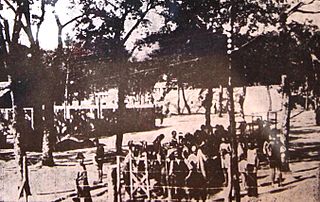
Renicci is a village in the municipality of Anghiari, which was the site of a fascist concentration camp for civilians from Yugoslavia, mostly rounded up by Italian troops in Slovenia and in particular in the then Province of Ljubljana. It is estimated that in eleven months of activity, the camp hosted about ten thousand prisoners, 159 of whom lost their lives because of the prohibitive conditions of detention. The remains of most of the victims are kept in the Shrine of the Slavs located within the Sansepolcro cemetery. After decades of neglect, recently in the area where the concentration camp lied, the Renicci Memorial Park was built, and annually hosts the celebrations for the Day of Remembrance.
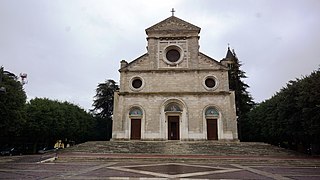
Avezzano Cathedral is a Roman Catholic cathedral dedicated to Saint Bartholomew in Avezzano, Abruzzo, Italy. There have been churches on the site since the 11th century but earthquakes have repeatedly destroyed them; the present cathedral dates from after the great earthquake of 1915.

Lucus Angitiae was an Italic and Roman town and sanctuary with temple of the goddess Angitia, the ruins of which are located in the comune of Luco dei Marsi in the Abruzzo region of Italy.

Monte Salviano is a massif in the Abruzzo Apennines, Central Italy. It includes the peaks of Monte d'Aria, Monte Cimarani and Monte San Felice. Since 1999 the area, falling within the municipal territory of Avezzano, has been included in the Riserva Naturale di Monte Salviano.

The Piani Palentini is a plateau in upper Marsica, a subregion of Abruzzo, in central Italy.
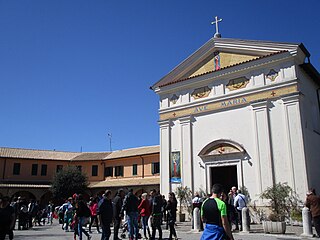
The Sanctuary of the Madonna di Pietraquaria is a church situated on Mount Salviano at about 1,000 metres ASL in the municipal territory of Avezzano, Abruzzo, Central Italy.

Madonna di Pietraquaria is one of the titles by which the Holy Virgin Mary is venerated as the Patroness of the city of Avezzano, in Abruzzo, Italy. On 1 January 1978, Maria Santissima di Pietraquaria was proclaimed the patroness saint of the city of Avezzano. The Virgin Mary is celebrated with events and religious rites between 25 and 27 April.
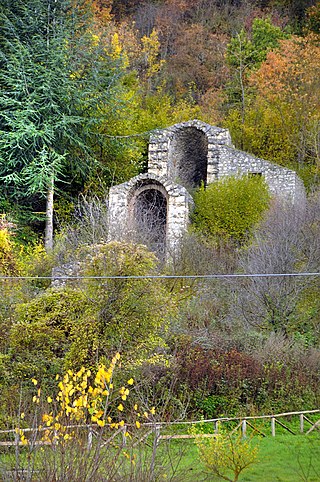
The Tunnels of Claudius consist principally of a 6 km-long tunnel together with several monumental service tunnels which Roman Emperor Claudius had built by 52 AD to partially drain the Fucine Lake in Abruzzo, protecting riparian villages from floods and creating agricultural land. It was a massive engineering project involving 30000 workmen and slaves who completed it in just 11 years, and considered among the grandest in antiquity. It was the longest tunnel ever built until the inauguration of the Fréjus Rail Tunnel in 1871.
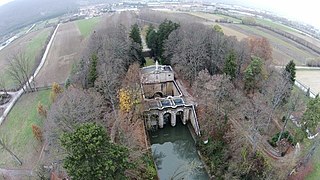
The Fucine Inlet is a monument built on the head of the main emissary of the Fucine Lake in Italy. It is made up of the three-arched bridge of the sluice gates and the about 7-metre-high (23 ft) statue of the Immaculate Conception rising above. It is situated in Borgo Incile, a locality south of the city of Avezzano, in the Fucine plain, Abruzzo, Central Italy. The facility necessary for the drainage of the Fucine Lake connects the outer drainage canal to the underground emissary which is served by the system of the Tunnels of Claudius in Mount Salviano. The monument was made in 1876 by architect Carlo Nicola Carnevali.

The Riserva Naturale di Monte Salviano or Riserva naturale guidata Monte Salviano is a nature reserve in Abruzzo, Italy, established in 1999. It lies in the territory of the comune (municipality) of Avezzano, in the Province of L'Aquila. The reserve is named after Monte Salviano, a massif that extends northwest to southwest dividing the Fucine basin from the Palentine Plains, in the Marsica sub-region.

The Capistrello massacre was a mass killing carried out in Capistrello, a small town in Abruzzo, Italy, on 4 June 1944 by Nazi and Fascist occupation troops during World War II. A first tragical episode occurred a few months earlier on 20 March, when a local youth was barbarically tortured and then shot. The following roundup made by Nazists and Fascists on the slopes of Mount Salviano led to the capture and torture of 33 shepherds and breeders. The shooting occurred near Capistrello railway station.
Alfredo Lucio Esposito, also known under the pseudonym of Alfredo Fiorani, was an Italian poet, writer, essayist and man of letters.

























